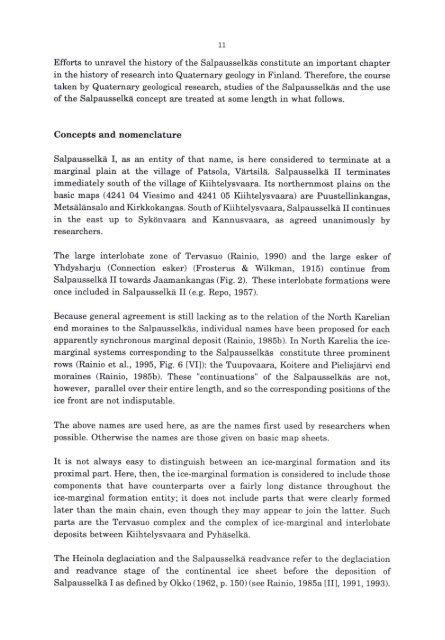DEGLACIATION IN EASTERN AND CENTRAL ... - arkisto.gsf.fi
DEGLACIATION IN EASTERN AND CENTRAL ... - arkisto.gsf.fi
DEGLACIATION IN EASTERN AND CENTRAL ... - arkisto.gsf.fi
You also want an ePaper? Increase the reach of your titles
YUMPU automatically turns print PDFs into web optimized ePapers that Google loves.
11<br />
Efforts to unravel unravel the his history tory of of the Salpausselkäs constitute an important chapter<br />
in the the his history tory of ofresearch research into Quaternary geology geology in Finland. Finland. Therefore, Therefore, the course<br />
taken taken by by Quaternary geological research, research, studies of the Salpausselkäs Salpausselkeis and the use<br />
of of the the Salpausselkä concept are treated treated at some length length in in what what follows. follows.<br />
Concepts an and d nomenclature<br />
Salpausselkä I, as as an entity entity of of that that name, is here here considered to to terminate at a<br />
marginal plain at the the village village of Patsola, Patsola, Värtsilä. Värtsilä. Salpausselkä Salpausselkä 11 II terminates<br />
immediately south south of the village village of Kiihtelysvaara. Kiihtelysvaara. Its Its northernmost northernmost plains plains on the<br />
basic maps (4241 04 Viesimo Viesimo and 4241 424L 05 Kiihtelysvaara) Kühtelysvaara) are Puustellinkangas,<br />
Metsälänsalo and Kirkkokangas. South ofKiihtelysvaara, of Kiihtelysvaara, Salpausselkä 11 II continues<br />
in the east up up to Sykönvaara Sykönvaara and and Kannusvaara, Kannusvaara, as agreed unanimously by<br />
researchers.<br />
The large interlobate zone zone of of Tervasuo Tervasuo (Rainio, 1990) l-990) and and the large large esker of<br />
YhdyshaIju Yhdysharju (Connection esker) esker) (Frosterus & Wilkman, 1915) 1915) continue from<br />
Salpausselkä 11 II towards Jaamankangas Jaemankangas (Fig. 2). 2). These These interlobate formations fomations were<br />
once included in in Salpausselkä 11 II (e.g. Repo, 1957). 1957).<br />
Because Because general agreement is is stilllacking still lacking as to the relation of the North Karelian<br />
end end moraines to to the Salpausselkäs, individual individual names nrmes have been proposed for each<br />
apparently synchronous marginal deposit (Rainio, 1985b). 1985b). In North Karelia the icemarginal<br />
systems corresponding to to the Salpausselkäs constitute three prominent prominent<br />
rows (Rainio et al., al., 1995, Fig. 6 6 [VI)): IVIJ): the Tuupovaara, Koitere and Pielisjärvi end<br />
moraines (Rainio, 1985b). These "continuations" of the Salpausselkäs are not,<br />
however, parallel parallelover over their entire length, length, and so so the corresponding positions ofthe<br />
ice ice front are not indisputable.<br />
The above names are are used here, as are the names <strong>fi</strong>rst <strong>fi</strong>rst used by by researchers when<br />
possible. possible. Otherwise the names are those given on basic map sheets.<br />
It is not always easy to distinguish between between an ice-marginal formation and its its<br />
proximal part. pa..--t. Here, then, the ice-marginal formation is considered to include those<br />
components that have counterparts over a fairly long distance throughout the<br />
ice-marginal formation entity; it it does not include parts that were clearly formed<br />
later than the main chain, even though they may appear to join the latter. Such<br />
parts are the Tervasuo complex and the complex of ice-marginal and and interlobate interlobate<br />
deposits between Kiihtelysvaara and Pyhäselkä.<br />
The Heinola deglaciation and the the Salpausselkä readvance refer refer to the deglaciation<br />
and readvance stage of the continental ice sheet before the deposition of<br />
Salpausselkä I as de<strong>fi</strong>ned by Okko (1962, p. 150) (see Rainio, 1985a [II], 1991, 1993).<br />
Salpausselkä I as de<strong>fi</strong>.ned by Okko ( 1962, p. 150) (see Rainio, 1985a [II], 1991, 1993).

















